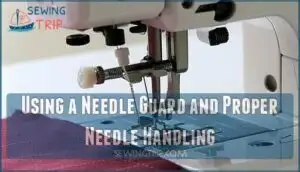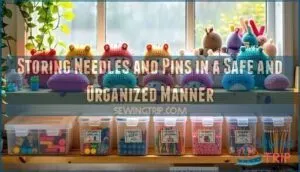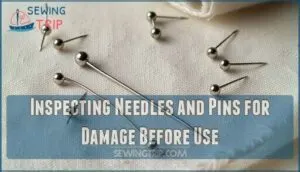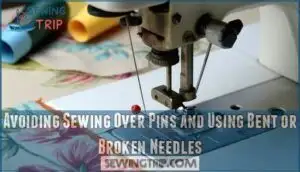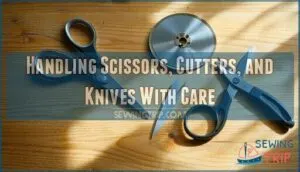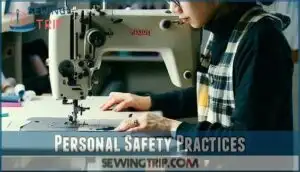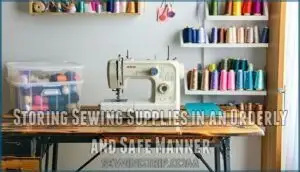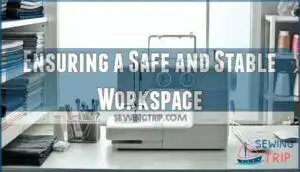This site is supported by our readers. We may earn a commission, at no cost to you, if you purchase through links.
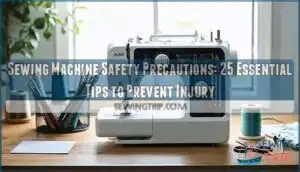
Always unplug the machine when you’re done—no one wants a rogue needle incident. Keep your sewing area tidy; a clutter-free space means fewer accidents.
Use a needle guard and avoid sewing over pins—trust me, needles and metal don’t mix. Tie back long hair, skip the loose sleeves, and keep distractions to a minimum (Netflix can wait).
Regularly inspect and maintain your machine to prevent mishaps. Safe sewing is smart sewing—get comfy with these basics, and you’ll sew like a pro!
Table Of Contents
Key Takeaways
- Unplug your machine after use and inspect it regularly to prevent accidents and electrical hazards.
- Keep your sewing area tidy—store sharp tools securely and maintain a clutter-free space for better organization and safety.
- Always keep your fingers at least an inch from the needle and use tools like pushers or seam guides for fabric handling to avoid injuries.
- Tie back loose hair, avoid flowing clothing, and stay focused—distractions and improper attire are major safety risks.
General Safety Precautions
Before you start your next sewing project, you’ll want to establish basic safety habits that prevent most machine-related accidents.
These fundamental precautions protect both you and your equipment while creating a stable foundation for safe sewing practices.
Turning Off The Machine When Not in Use
You wouldn’t leave your car running in the garage, so don’t leave your sewing machine powered on when you’re done.
Turning off your machine prevents accidents and saves energy through proper machine shutdown protocols. Proper sewing machine safety is vital for preventing injuries.
Essential sewing machine safety precautions include:
- Automatic Off features reduce electrical hazards
- Power Savings extend machine lifespan substantially
- Energy Efficiency lowers electricity bills monthly
- Idle Mode prevents overheating during breaks
- Machine Shutdown eliminates accidental activation risks
Unplugging The Machine When Not in Use
Beyond switching off your machine, you’ll want to unplug it completely for maximum electrical safety.
This simple habit prevents accidental startup and reduces energy consumption when you’re not sewing.
Unplugging also protects against power surges that could damage internal components, it’s your best defense for accident prevention and guarantees true machine shutdown.
Think of it as your safety net.
Regular Machine Maintenance and Inspection
Keeping up with regular sewing machine maintenance prevents costly breakdowns and dangerous malfunctions.
Regular sewing machine maintenance is your best defense against breakdowns and ensures safe, smooth stitching every time.
Your machine needs consistent care to operate safely and efficiently. Professional servicing every two years guarantees peak performance, while routine inspections catch problems early.
Essential maintenance tasks include:
- Machine Cleaning – Remove lint buildup and debris after each project
- Oil Checks – Lubricate moving parts monthly following manufacturer guidelines
- Noise Inspection – Listen for unusual sounds indicating Part Replacement needs or Wire Maintenance issues
Using Heavy-duty Extension Cords and Proper Voltage
Power management starts with matching your machine’s voltage requirements to your electrical supply.
Check your owner’s manual for exact specifications before plugging in.
Heavy-duty extension cords prevent overheating and reduce electrical hazards that could cause electric shock.
Surge protection safeguards expensive equipment from power fluctuations.
When working with thick fabrics, understanding heavy duty features is vital for superior performance and safety.
| Safety Check | Required Action | Risk Prevention |
|---|---|---|
| Voltage Checks | Match machine rating to outlet | Prevents equipment damage |
| Cord Safety | Use 12-gauge minimum wire | Reduces fire hazards |
| Power Management | Avoid daisy-chaining extensions | Eliminates overload risks |
| Electrical Hazards | Inspect cords for damage | Prevents shock injuries |
To ensure electrical safety, it is crucial to follow these guidelines carefully, as they help prevent equipment damage and reduce the risk of fire hazards.
By taking these precautions, you can work safely and efficiently with your machine.
Keeping The Sewing Area Clutter-free and Organized
A cluttered sewing space invites accidents waiting to happen.
Clear walkways prevent trips and falls that could send you tumbling into sharp objects.
Store supplies in designated containers to avoid stepping on dropped pins.
Keep your workspace organized with proper storage solutions.
Clean surfaces regularly to maintain visibility and prevent fabric snags.
Your sewing room organization directly impacts your safety and project success.
Needle and Sharp Object Safety
Sharp objects like needles, pins, and scissors pose the highest injury risk in your sewing workspace, causing cuts, punctures, and even eye injuries when mishandled.
You’ll prevent most accidents by inspecting these tools before each use, storing them properly, and never rushing when handling them, which are complete concepts to ensure safety, and following these steps will help minimize the risk of injury from sharp objects.
Using a Needle Guard and Proper Needle Handling
Your needle’s the sharpest tool in your sewing arsenal, so treat it with respect. Proper needle handling and guards aren’t just suggestions—they’re your first line of defense against painful punctures and costly machine damage.
Respect your needle—it’s your sharpest ally, but mishandled, it can turn into your quickest sewing disaster.
Here are five essential needle safety practices:
- Install needle guards on your sewing machine to create a protective barrier around the needle area
- Inspect each needle before use, checking for bends, burrs, or damage that could cause injury
- Use the correct needle type for your fabric weight to prevent breakage and dangerous projectiles
- Keep fingers at least one inch away from the needle while sewing to avoid accidental contact
- Replace damaged needles immediately rather than risking machine damage or personal injury
Using a needle guard system can substantially enhance your sewing safety and efficiency.
Smart needle handling transforms your sewing experience from risky to reliable.
Storing Needles and Pins in a Safe and Organized Manner
Smart pin storage keeps your sewing room safe and organized.
Use needle cases or sewing kits with sharp containers to prevent accidental cuts.
A pin cushion keeps pins within reach while protecting fingers.
Safety boxes work well for bulk storage of sewing machine needles.
Store everything in dedicated compartments to avoid dangerous surprises when reaching for supplies.
Proper pin storage solutions involve using pin storage cases to keep workspaces tidy and secure.
Inspecting Needles and Pins for Damage Before Use
Before threading your sewing machine needles, run your fingertips along each needle’s surface to detect burrs or rough spots.
Check for bending, blunting, or chipping that could damage fabric or cause thread breakage.
Pin care requires the same attention—inspect for deformation or wear.
This simple needle inspection prevents costly fabric damage and guarantees your sewing precautions keep you safe while creating.
Avoiding Sewing Over Pins and Using Bent or Broken Needles
After checking your needles and pins for damage, resist the temptation to sew over pins still in your fabric.
This common mistake causes needle breakage, fabric damage, and potential machine malfunction.
Remove pins as you approach them during stitching.
Bent or broken needles create dangerous projectiles and poor stitch quality.
Replace damaged needles immediately to prevent sewing accidents and maintain proper needle care for superior sewing machine safety precautions.
Handling Scissors, Cutters, and Knives With Care
Sharp cutting tools demand your full attention and respect. Store scissors, rotary cutters, and craft knives with blade guards on to prevent accidental cuts.
Keep cutting tools away from children and maintain sharp edges through proper scissor maintenance and blade care.
A dull blade requires more pressure, increasing your risk of slipping and causing sewing accidents or injury.
Personal Safety Practices
Your personal habits and behaviors directly impact your safety while using a sewing machine.
You’ll need to maintain proper body positioning, secure loose items, and stay focused to prevent accidents that can happen in seconds.
Maintaining a Safe Distance From The Needle
Keep your fingers at least one inch away from the needle at all times.
This safe distance prevents accidental contact during fabric control. Use specialized tools like seam guides or fabric pushers instead of your hands for precise positioning.
Proper hand placement and a needle guard provide essential injury prevention. Remember, maintaining distance isn’t just cautious—it’s smart sewing machine safety that keeps your fingers intact, which is a matter of complete concepts.
Tying Back Long Hair and Avoiding Loose Clothing
Your hair poses a serious entanglement risk around moving machine parts.
Pull back long hair with hair ties before you start sewing.
Loose clothing creates similar hazards – avoid flowing sleeves, dangling jewelry, and untied scarves.
Safe attire means fitted clothes that won’t catch in mechanisms.
Proper sewing posture keeps you stable while maintaining fabric control throughout your project.
Keeping Fingers Away From The Needle and Using Tools for Guidance
Your fingers should stay at least one inch from the needle at all times. Think of it as your personal safety zone.
Instead of using your hands for fabric control, reach for specialized sewing aids that keep you protected.
- Finger guards create a protective barrier between you and the needle
- Seam guides help maintain straight lines without hand placement near danger zones
- Fabric pushers allow precise control while maintaining safe needle distance
- Quilting gloves provide grip without compromising hand safety
- Magnetic seam guides offer hands-free fabric control for consistent results
These sewing machine safety tools aren’t just accessories—they’re your insurance policy against accidents. Proper sewing precautions mean treating every stitch like it matters, because your fingers definitely do.
Avoiding Distractions and Maintaining Focus on The Task
Beyond keeping your hands safe, your mind needs protection too.
Distractions turn sewing machines into accident magnets. Turn off the TV, silence your phone, and focus entirely on your needle’s path.
When someone calls your name, stop immediately—don’t risk a finger for politeness.
Mindful sewing prevents injuries better than any safety device. Your project can wait; your fingers can’t heal as easily.
By following proper sewing safety tips, you can substantially reduce the risk of accidents and guarantee a safe sewing experience, which is crucial for mindful sewing.
Taking Breaks and Avoiding Fatigue
Staying focused is key, but pushing through exhaustion can backfire. Fatigue clouds judgment and invites mistakes.
Follow these sewing safety tips:
- Take a 10-minute Break Time every hour.
- Stretch to boost circulation and prevent stiffness.
- Rest your eyes to avoid strain.
- Stay hydrated for better focus.
- Pause if frustration builds—your Mental Health matters.
Child and Environmental Safety
You’ve got to keep safety in mind when kids and sewing machines share a space.
By securing sharp tools and teaching basic rules, you’ll create a safer environment for everyone.
Keeping Sewing Machines and Sharp Objects Out of Children’s Reach
Even the best sewing machine safety precautions can’t replace vigilance.
Keep sewing machines and sharp tools in secure storage, like locked cabinets, to prevent sewing machine accidents.
Create kid-friendly zones far from sewing areas.
Supervise children closely if they’re nearby.
Remember, curiosity and sharp objects don’t mix—better safe than sorry.
It’s essential to follow proper safety machine tips to minimize risks.
| Safety Measure | Description |
|---|---|
| Secure Storage | Lock tools in cabinets or containers. |
| Kid-Friendly Zones | Designate areas free from sharp objects. |
| Child Supervision | Always monitor children around machines. |
| Accident Prevention | Keep tools inaccessible to little hands. |
Storing Sewing Supplies in an Orderly and Safe Manner
Keeping sewing supplies organized isn’t just about neatness—it’s about safety too.
Avoid accidents with these tips:
- Use safety containers for needles, pins, and scissors.
- Label storage bins for easy access.
- Install secure shelves to prevent falling items.
- Store heavy tools low for storage safety.
- Keep a tidy workspace to enhance sewing room safety.
Orderliness protects everyone!
Educating Children About Sewing Machine Safety
Teaching kids sewing machine safety doesn’t have to feel like pulling teeth.
Start with simple rules: no touching buttons without permission and always unplugging after use.
Use games like Simon Says to make safety awareness fun.
Here’s a quick guide:
| Safety Tip | Why It Matters | How to Teach It |
|---|---|---|
| Unplug after sewing | Prevents accidents | Demonstrate unplugging |
| No loose clothing | Avoids entanglement | Show proper attire |
| Closed-toe shoes | Protects feet | Make it a rule |
| Hands off the needle | Prevents injuries | Highlight the danger zone |
| Slow machine speed | Improves control | Adjust speed settings |
The key to successful teaching is to make the experience enjoyable and interactive, while also emphasizing critical safety rules such as unplugging the machine after use and keeping hands off the needle to prevent injuries.
Ensuring a Safe and Stable Workspace
A safe workspace starts with proper workspace planning.
Verify your sewing machine sits on a stable, flat surface to prevent tipping.
Clear clutter to maintain floor clearance and reduce sewing room hazards.
Use cable management to avoid tripping and guarantee electrical safety.
Prioritize ergonomic setup for comfort.
Safe storage of tools keeps accidents at bay while boosting sewing machine safety precautions.
Disposing of Waste and Unwanted Materials Properly
A tidy workspace isn’t just about organization—it’s about safety.
Proper disposal of waste reduces sewing room hazards and supports eco-friendly practices.
Follow these steps:
- Use a designated bin for scraps and sharp objects.
- Recycle fabric and paper waste when possible.
- Safely discard damaged needles and blades in puncture-proof containers.
- Avoid leaving tangled threads that could cause accidents.
By following these simple guidelines, you can maintain a tidy workspace that is both efficient and safe.
Machine Maintenance and Repair
Keeping your sewing machine in top shape isn’t just about smooth stitching—it’s about safety too.
Regular maintenance and prompt repairs prevent accidents and keep your projects running without a hitch.
Regularly Servicing The Sewing Machine Every 2 Years
A well-maintained sewing machine is like a loyal friend—it works smoothly when cared for.
Schedule professional sewing machine servicing every two years to catch hidden issues.
Regular machine checks, oil replacement, and part inspection keep maintenance costs low and extend your machine’s life.
Here’s a quick breakdown of benefits:
| Task | Frequency | Benefits |
|---|---|---|
| Machine Checks | Every 2 Years | Prevents breakdowns |
| Oil Replacement | Regularly | Smooth operation |
| Part Inspection | Biennially | Avoids costly repairs |
| Service Scheduling | Planned | Saves time and money |
| Maintenance Costs | Reduced | Long-term savings |
Inspecting The Machine for Damage or Wear Before Use
Before sewing, a quick machine inspection avoids surprises.
Use this pre-use checklist:
- Power Cord: Check for frays or exposed wires.
- Needle: Confirm it’s straight and secure.
- Screws: Tighten loose ones to minimize vibrations.
- Exterior: Look for cracks or worn parts.
Spotting wear early prevents sewing machine hazards and verifies safety verification.
Cleaning and Oiling The Machine Regularly
Every few months, grab your cleaning tools and give your machine a little TLC.
Dust buildup can wreak havoc, so clear it out with a lint brush.
Use the right oil types—check your manual—to prevent oil leaks and keep parts running smoothly.
Stick to maintenance schedules for consistent sewing machine care.
Proper lubrication techniques guarantee smooth stitching and better machine performance.
Regular use of sewing machine oil is vital for maintaining machine longevity.
Replacing Broken or Damaged Parts Promptly
Don’t wait to replace broken needles or damaged parts—they’re accidents waiting to happen.
Regular damage inspection guarantees machine guarding stays effective. Keep spare parts handy for prompt repair and smoother sewing.
Ignoring part replacement risks ruining projects or worse, causing injuries. Prioritize sewing machine safety by making part replacement a key step in your sewing machine maintenance routine, and consider prompt repair as essential.
Following Proper Repair and Adjustment Procedures
When tackling sewing machine repair, precision matters. Always unplug the machine first—no one wants a surprise zap! Use proper tools and follow the manual to avoid mishaps.
- Double-check adjustments to guarantee alignment and smooth operation.
- Tighten screws securely to prevent vibrations.
- Test repairs with scrap fabric before diving into projects.
These sewing machine safety tips keep you stitching confidently!
Frequently Asked Questions (FAQs)
What Safety Measures Should I Take When Cutting Fabric?
Did you know about 3,000 ER visits yearly involve fabric-cutting injuries?
Always use sharp scissors or rotary cutters on a stable surface.
Keep fingers clear, store tools safely, and never rush—it’s precision over speed!
How Often Should I Service My Sewing Machine?
You should service your sewing machine at least once every two years.
If you sew often or hear odd noises, schedule maintenance sooner.
Think of it like a car—regular care keeps it running smoothly.
What Should I Do to Avoid Injury When Using a Sewing Machine?
Imagine your hand near a zipping needle—it’s a split-second mishap waiting to happen.
Always keep fingers an inch away, tie back loose hair, focus fully, and use tools—not hands—for fabric guidance to prevent accidents, with complete concepts of safety in mind being crucial.
How Should I Store My Cutting Tools Safely?
Store cutting tools in a secure, designated spot—like a toolbox or drawer—with blade covers in place.
Keep them out of kids’ reach.
Avoid cluttered areas where accidents can happen.
Safety first, always sharp!
Is It Safe to Allow Children to Be Around Sewing Equipment?
It’s safe if you supervise and secure sharp tools.
Teach them basic safety rules, like keeping fingers away from needles.
Treat it like a mini-driver’s ed: focus, control, and no distractions allowed!
What are the safety precautions when using a sewing machine?
A sewing machine can be as safe as a kitten if used smartly.
Unplug it after use, secure loose hair and clothing, mind your fingers, inspect for damage, and keep sharp tools organized.
What are the 10 safety precautions used in a machine shop?
Wear safety goggles, secure loose clothing, and use protective gloves.
Keep tools organized, follow machine guidelines, and maintain clean workspaces.
Stay focused, inspect equipment regularly, unplug machines after use, and report malfunctions immediately.
What are the hazards of sewing machine?
Picture a slippery slope—rushed sewing can lead to needle injuries, electric shocks, or fire hazards.
Loose threads, damaged cords, and cluttered areas spell trouble.
Stay alert, minimize distractions, and don’t wing machine maintenance!
What are machine safety precautions?
Unplug your machine when not in use, inspect cords for damage, and tighten screws to prevent vibrations.
Keep fingers clear, tie back hair, and focus.
Remember, safety isn’t optional—it’s your best sewing tool.
How to properly store fabric scraps after use?
Fold, sort, and store fabric scraps in clear zippered bags or stackable bins to stay organized.
Label everything by size or color.
Keep them off damp floors to avoid mildew—no one likes soggy fabric!
Conclusion
Think of your sewing machine as a trusted ally—it works best when treated with care and respect.
Following sewing machine safety precautions isn’t just about avoiding injuries; it’s about creating a reliable, stress-free workspace.
Keep your tools organized, inspect your machine regularly, and avoid distractions while sewing.
A tidy area and a focused mind will keep mishaps at bay.
Safe habits guarantee both you and your projects stay intact, proving that smart sewing is always better sewing!

